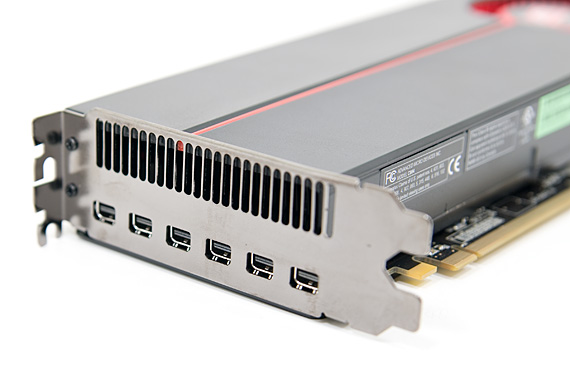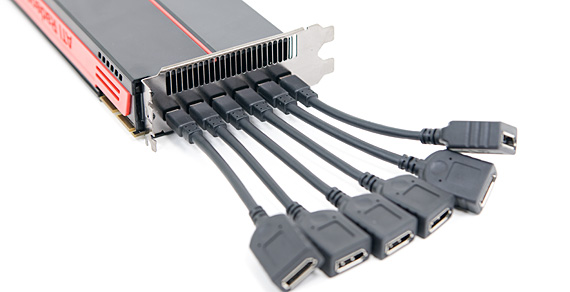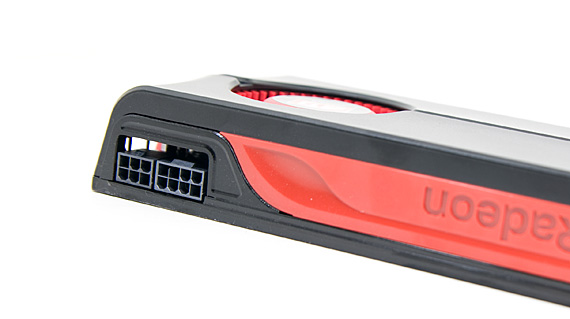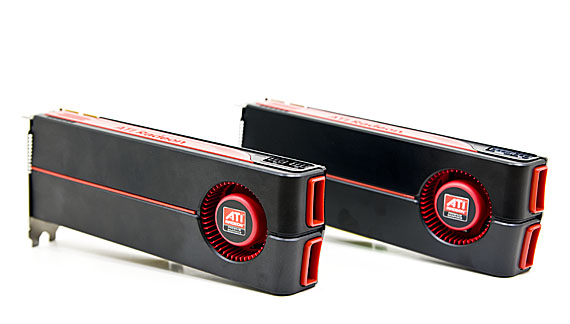AMD's Radeon HD 5870 Eyefinity 6 Edition Reviewed
by Anand Lal Shimpi on March 31, 2010 12:01 AM EST- Posted in
- GPUs
The first time I laid eyes on this card I was visiting AMD's headquarters in Sunnyvale before the Radeon HD 5800 series launch event. I could take photos of the 6 displays it was driving, but not the card itself. So we'll start off with a picture of the things that set the Radeon HD 5870 Eyefinity 6 Edition card apart from its 3-display counterpart.
The most obvious changes are the display outputs. While your standard 5870 has two DL-DVI, one DisplayPort and one HDMI output, the Eyefinity 6 Edition has six mini Display Port connectors.

You can further convert two of those DP outputs into any combination of DVI, HDMI (only one can be HDMI) and VGA. The remaining four connectors must remain Display Port due to the limited number of timing sources on the 5870. The card will come with two mini DP to DP adapters, 2 passive mini DP to SL-DVI dongles and one passive mini DP to HDMI dongle.

Clock speeds have not changed. The GPU still runs at 850MHz core and the memory runs at a 1.2GHz clock speed (4.8GHz data rate). Memory size did change however, the Eyefinity 6 Edition card ships with 2GB of GDDR5 to accommodate the resolutions this thing will be driving. As 256MB GDDR5 is still not available for mass production (and won't be until later this year), AMD is using 16 x 128MB GDDR5 chips in 16-bit mode.
| AMD Radeon HD 5970 | AMD Radeon HD 5870 Eyefinity 6 | AMD Radeon HD 5870 | AMD Radeon HD 5850 | |
| Stream Processors | 2x1600 | 1600 | 1600 | 1440 |
| Texture Units | 2x80 | 80 | 80 | 72 |
| ROPs | 2x32 | 32 | 32 | 32 |
| Core Clock | 725MHz | 850MHz | 850MHz | 725MHz |
| Memory Clock | 1GHz (4GHz data rate) GDDR5 | 1.2GHz (4.8GHz data rate) GDDR5 | 1.2GHz (4.8GHz data rate) GDDR5 | 1GHz (4GHz data rate) GDDR5 |
| Memory Bus Width | 2x256-bit | 256-bit | 256-bit | 256-bit |
| Frame Buffer | 2x1GB | 2GB | 1GB | 1GB |
| Transistor Count | 2x2.15B | 2.15B | 2.15B | 2.15B |
| TDP | 294W | 228W | 188W | 151W |
| Manufacturing Process | TSMC 40nm | TSMC 40nm | TSMC 40nm | TSMC 40nm |
| Price Point | $699 | $479 | $390-420 | $300 |
As a result of the added memory, power consumption has also gone up slightly. The Radeon HD 5870 Eyefinity 6 Edition now requires both a 6-pin and an 8-pin PCIe power connector instead of the two 6-pin connectors of the stock 5870:

The extra memory and five adapters that you get in the box do come at a price. The Radeon HD 5870 E6 Edition is expected to retail for $479. That's $100 more than the MSRP of the 5870 but only $59 more than its actual street price. It remains to be seen what the street price of the 5870 E6 will end up being given that TSMC 40nm production is still limited with improved but not yet perfect yields. These cards should be available immediately.
Update 4/1/2010: Launch prices appear to have missed their target. We're seeing the 5870E6 sold out at $499, and in-stock elsewhere at $549. This puts it at an $80 premium over the reference 1GB 5870.











78 Comments
View All Comments
fernando.gomes@ydreams.com - Wednesday, March 31, 2010 - link
Hi, Anand.Did you have a chance to try (or ask the AMD guys) about 12 screens? Crossfiring 2 E6 cards makes you wonder about that chance.
I once had a chance to put up a 4x3 screen, 2 years ago, with absolutely no bezel whatsoever, but that set up cost my company an insane amount of money. Each screen cost 7.000$, for starters.
I see this E6 as an alternative to keep an eye on. I couldn't care less about the bezel problems, as my company usually sets up multiscreen displays either with projectors or with bezelless LCD's, but 6 displays might not be enough for our line of work.
So, can it be crossfired to a 12 screen 3D accelerated output ? (I'm not concerned about performance, as our apps usually don't stress GPU's much)
fernando.gomes@ydreams.com - Wednesday, March 31, 2010 - link
When I wrote "a 4x3 screen", I meant "a 4x3 multi-screen display, as per 12 x 720p displays arranged in a 4x3 grid"
PS: damn, we should be able to edit our own posts!
Ryan Smith - Wednesday, March 31, 2010 - link
It can be done. They had it working under Linux using X-Plane back at their September launch. However it's not even close to being in a shipping state, and I don't have the foggiest idea when it would be.fernando.gomes@ydreams.com - Wednesday, March 31, 2010 - link
Thanks for the quick reply, Ryan.Can you tell me how that works, in practice. Now that Windows 7 (and Vista) ditched horizontal spanning, I can't just set my company's apps to 3072x768 (3 screens), because that resolution is not even made available by the driver anymore.
From my previous experiente, I can say that as long I have the taskbar spanned through 3 screens, it is safe to assume that I will be able to accelerate 3D apps at the same resolution as the desktop, at least.
Eyefinity must be somewhat different. If the Catalyst 10.3 is still compliant with WDDM 1.1, then I'm guessing our 3D engine must be 'approved' or at least able to aknowledge the availability of Eyefinity.
Back in the XP days, spanning throug 2 screens was transparent - the 3D app didn't even know it was outputting to 2 or more screens, but with eyefinity, compatibility must be achieved at a much lower level. Is that right?
I'm sorry to bother you, but I don't have access to a hands-on approach.
Thanks,
Fernando
fernando.gomes@ydreams.com - Wednesday, March 31, 2010 - link
I'm sorry for the long post, guys.Shorter version:
- Does the desktop look like XP in Span mode ?(I think I see a taskbar streched along 3 screens, in Anand's video)
- when you run a 3D app (one that is NOT oficially compatible), will 'awkward' resolution (say 5760x2160) be availabe as a choice?
If you answer YES to these 2, then I'm saved, and I'm in trouble aswell, as my company only supports Nvidia (and changing this standard will cost a lot, testing in Quality Assurance will be havoc. Time for a change, I guess. :)
Fernando
Ryan Smith - Wednesday, March 31, 2010 - link
Background info: Eyefinity is the trade name for what AMD calls Single Large Surface technology. SLS operates pretty much as how the name implies: the drivers provide a very large resolution option for applications to work with, and then AMD's hardware takes care of chopping up the image for multiple monitors. Providing the OS/software with a very large resolution is the fundamental aspect behind Eyefinity.So to answer your questions, yes, 3D games see the large resolution. As for the desktop I've never tried it (and Anand currently has all of our Eyefinity gear). To applications/games at least, this is completely transparent. Eyefinity support basically amounts to being able to handle the oddball aspect ratios and the higher resolutions.in the case where resolutions are hard-coded in.
vgdarkstar - Wednesday, March 31, 2010 - link
I would like to point out to all the naysayers of multimon, you stop seeing the bezels after using it for a bit. Do you notice your nose? it's the same effect.Anand Lal Shimpi - Wednesday, March 31, 2010 - link
I agree with that completely which is why I said it wasn't an issue in a 3x1 setup. However in the case of a 3x2 configuration you always notice the bezels in the center of your screen because they often occlude important information (e.g. dialog boxes, crosshairs, etc...).Take care,
Anand
Zstream - Wednesday, March 31, 2010 - link
Why is it that people believe this setup is meant just for gaming? What about people who can have six LCD screens monitoring all sort of devices in a corporate world? What about those who use photoshop and can use other multi-monitor software?Just a thought, not all geeks are gamers you know ;)
Anand Lal Shimpi - Wednesday, March 31, 2010 - link
Oh I agree, and that's why I mentioned dialog boxes as being a problem. Honestly I think the biggest application for a 6-display setup right now is for more than just gaming. It's just a shame that you have to buy a $479 gaming card to enable it :)Take care,
Anand